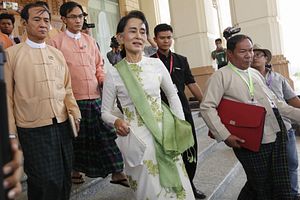The expectations for Myanmar’s new, National League for Democracy (NLD)-led government are almost impossibly high. After five decades under military or quasi-military rule, many Myanmar citizens expect the NLD government to make a decisive break with the country’s authoritarian past, while also promoting greater equality—and reforming the economy enough to foster stable growth that benefits more than just Myanmar’s elites. All these expectations are being heaped on a government led by ministers who, because of the country’s bleak political past, have little or no experience in governance and administration, and who belong to a political party organized around the dominating figure of Aung San Suu Kyi. The fact that the armed forces have little intention of simply receding from politics, a position reiterated by the head of the military on Armed Forces Day last month, only further complicates the NLD’s ability to govern. Although there are regional examples of countries, like Indonesia, where the armed forces have eventually been maneuvered out of politics, there are also many Southeast Asian examples, like neighboring Thailand, where the generals never really returned to the barracks.
Some younger NLD members worry too, about Suu Kyi’s dominance—she has not only taken two ministerial positions but also a newly created position as minister counselor, making her a de facto head of state. The combination of portfolios held by the Nobel laureate, and the weak popular credentials of many other ministers, gives Suu Kyi enormous power in the policymaking process. In addition, the creation of the minister counselor position was essentially rammed through the lower house, worrying some MPs about the NLD’s commitment to seriously debating legislation.
Since taking office roughly two weeks ago, the new Myanmar government has made some positive moves. It has released most of the country’s remaining political prisoners, or announced plans to pardon them, a critical symbol that the new government will further relax freedom of expression and protest.
Yet other signs from the new government are more worrying, if perhaps predictable. The NLD’s economic and financial platform remains muddled, with party insiders suggesting that the senior leadership has no clear plan for how to continue Myanmar’s economic reforms while tweaking them to address the problem of growing inequality.
What’s more, during the campaign season last year, Suu Kyi and other NLD leaders remained ominously quiet about the campaign of violence against Rohingya and other Muslims in Myanmar, a campaign that has decimated the Rohingya community. When Suu Kyi did talk to the press or the public about Buddhist-Muslim tensions, she tended to downplay them, telling reporters not to “exaggerate” the problems of the Rohingya. Shortly after the new government took office in late March, it announced that the spokesman for the former, Thein Sein government, Zaw Htay, would be retained and promoted. Zaw Htay is widely known in Myanmar for his inflammatory remarks about the Rohingya, including posting photos online that exacerbated tensions between Buddhists and Muslims, according to the Irrawaddy. Meanwhile, the new minister for religious affairs, Aung Ko (who does not come from the NLD), last week called Muslims “associate citizens,” implying that they did not deserve the same type of citizenship as Buddhists. Myanmar media also revealed that Aung Ko has held meetings with U Wirathu, the firebrand nationalist monk, who is infamous for his anti-Muslim rhetoric.
Meanwhile, many other ministers in the new government appear unimpressive. In addition to concern about some ministers’ dubious degrees, many members of the Cabinet are close political allies of the former speaker of the lower house, Thura Shwe Mann. As the Irrawaddy has noted, many of these allies of Shwe Mann have alleged links with companies that, under the military regime, were close to the generals and accused of illegal activities like corruption and drug trafficking, among others.
Joshua Kurlantzick is a fellow for Southeast Asia at the Council on Foreign Relations. This post appears courtesy of CFR.org.

































